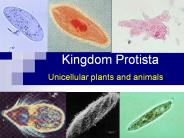Protista PowerPoint PPT Presentations
All Time
Recommended
Title: Photosynthetic Prokaryotes Chapter 14 Author: Jeffery Hughey Last modified by: Hartnell Created Date: 6/28/2004 5:07:39 PM Document presentation format
| PowerPoint PPT presentation | free to download
Kingdom Protista: Algae and Heterotrophic Protists Chapter 15 Heterotrophic Phyla Oomycota- water molds. Myxomycota- plasmodial slime molds. Dictyosteliomycota ...
| PowerPoint PPT presentation | free to view
Saprophytic and engulf bacteria, yeast, fungal spores. Food reserve- glycogen. ... Photosynthetic Prokaryotes Chapter 14 Author: Jeffery Hughey Last modified by:
| PowerPoint PPT presentation | free to view
Animalia - Porifera. Animalia - Cnidaria. Corals - Tabulata, Rugosa, Scleractinia ... Animalia - Echinodermata. Animalia - Chordata. E.g. Amphibians, Reptiles, ...
| PowerPoint PPT presentation | free to view
Protists Kingdom Protista (The hodge-podge Kingdom)
| PowerPoint PPT presentation | free to download
PROTISTA Aditya Pusparajasa, S.Si PROTISTA??? Protista adalah kelompok makhluk hidup eukariotik uniseluler atau multiseluler yang belum terdeferensiasi menjadi ...
| PowerPoint PPT presentation | free to download
Kingdom Protista the protists Protista Characteristics Kingdom Protista Kingdom Protista Kingdom Protista Kingdom Protista Kingdom Protista Kingdom Protista ...
| PowerPoint PPT presentation | free to download
Kingdom Protista
| PowerPoint PPT presentation | free to download
Kingdom Protista Chapter 21
| PowerPoint PPT presentation | free to download
Kingdom Protista Diseases Caused by Protists Many protists are parasitic and can cause diseases in humans & other organisms such as: Malaria Amoebic dysentary ...
| PowerPoint PPT presentation | free to view
KINGDOM PROTISTA Biology 106 By: Sameera Haq Professor Taylor Anderson-McGill Its function is to regulate water and salt balance Is this eukaryotic or prokaryotic?
| PowerPoint PPT presentation | free to view
Rhizopoda yang hidup di laut memiliki cangkang keras untuk melindungi selnya yang terbuat dari silikon (contoh Radiolaria) atau kalsium karbonat (misal Foraminifera).
| PowerPoint PPT presentation | free to download
Kingdom Protista Chlamydomonas are actually unicellular and flagellated. Fungus-like protists, Myxomycota and Oomycota are decomposers. Phylum Myxomycota are made up ...
| PowerPoint PPT presentation | free to view
Oomycota (jamur air) Jamur air bersifat heterotrofik, baik secara parasit maupun saprofit. Contohnya : Phytophthora, Pythium, dan downy mildew.
| PowerPoint PPT presentation | free to download
Kingdom Protista Chlamydomonas are actually unicellular and flagellated. Fungus-like protists, Myxomycota and Oomycota are decomposers. Phylum Myxomycota are made up ...
| PowerPoint PPT presentation | free to view
Kingdom Protista Unicellular plants and animals General Information Protista, from the Greek protistos = first Diverse group Aka Algae & Protozoa Most are Unicellular ...
| PowerPoint PPT presentation | free to download
Kingdom Protista The most diverse kingdom Protist The protist kingdom contains the most diverse collection of organisms. Protist The one characteristics all protist ...
| PowerPoint PPT presentation | free to view
Title: Slide sem t tulo Author: win Last modified by: USER Created Date: 5/17/2004 10:26:50 PM Document presentation format: Apresenta o na tela (4:3)
| PowerPoint PPT presentation | free to view
Kingdom Protista TSW identify and describe the characteristics of Protists What is a Protist? Any organism that is not a plant, animal, fungus, or prokaryote First ...
| PowerPoint PPT presentation | free to download
Reino Protista Protozo rios Algas Morfologia e ultra-estrutura de protozo rios Caracter sticas dos protozo rios Unicelulares, alguns coloniais, alguns com etapas ...
| PowerPoint PPT presentation | free to download
Kingdom Protista (2) Biology 11 Mr. McCallum
| PowerPoint PPT presentation | free to view
KINGDOM PROTISTA Plant-like- Algae Animal-like- Protozoa Fungi-like- Slime Molds PHYLUM CHOROPHYTA (GREEN ALGAE) GREEN ALGAE CHLAMYDOMONAS Movement- two flagella ...
| PowerPoint PPT presentation | free to download
Title: Kingdom Protista Author: teacher Keywords: Kingdom Protista Description: Kingdom Protista Last modified by: Dad Created Date: 9/27/2004 11:20:49 AM
| PowerPoint PPT presentation | free to view
Kingdom Protista Chapter 20 Kingdom Protista Catch all Eukaryotes Unicellular and Multicellular Autotrophic or heterotrophic Some have cell walls Many have ...
| PowerPoint PPT presentation | free to view
Kingdom Protista Fidgety little critters! What is a Protist? Eukaryotic Has a nucleus! Mostly single celled Classified by: MOVEMENT OBTAIN FOOD Animal-like ...
| PowerPoint PPT presentation | free to download
Kingdom Protista Fidgety little critters! What is a Protist? Eukaryotic Has a nucleus! Mostly single celled Classified by: MOVEMENT OBTAIN FOOD Animal-like ...
| PowerPoint PPT presentation | free to download
Title: KINGDOM PROTISTA Protists Author: Kathy2 Last modified by: install Created Date: 1/31/2004 11:15:19 PM Document presentation format: On-screen Show (4:3)
| PowerPoint PPT presentation | free to download
Type 1 Type 2 Picture Representations of The Three Types of Protists Type 3a Type 3b
| PowerPoint PPT presentation | free to view
Kingdom Protista Fidgety little critters! What is a Protist? Eukaryotic Has a nucleus! Mostly single celled Classified by: MOVEMENT OBTAIN FOOD Animal-like ...
| PowerPoint PPT presentation | free to download
Kingdom Protista Unicellular plants and animals General Information Protista, from the Greek protistos = first Diverse group Aka Algae & Protozoa Most are Unicellular ...
| PowerPoint PPT presentation | free to download
... Phylum Apicomplexa All parasites Transmitted through blood-eating insects or feces Malaria One of ... kidney failure or brain damage Malaria and fake drugs: ...
| PowerPoint PPT presentation | free to download
Title: Slide 1 Author: ACER Last modified by: Saika Aulia Created Date: 10/2/2006 12:50:47 PM Document presentation format: On-screen Show Company
| PowerPoint PPT presentation | free to download
Kingdom Protista protozoans, algae, molds, and mildews Protozoans Heterotrophic Unicellular Animal-like (-zo-) Phylum Rhizopoda Move by pseudopodia Example is Amoeba ...
| PowerPoint PPT presentation | free to download
KINGDOM PROTISTA First appeared 1.5 billion years ago Eukaryotic Found in fresh or salt water Unicellular Lack specialized features No embryos or complex sex organs ...
| PowerPoint PPT presentation | free to download
Protists are unicellular organisms that have a nucleus. Kingdom: Protista * * * * Similar to Bacteria Unicellular One of the first groups of living things on Earth.
| PowerPoint PPT presentation | free to download
The kingdom Protista is paraphyletic and grouped for convenience ... Budding = Progeny cell smaller -Schizogony = Multiple fission. Sexual reproduction ...
| PowerPoint PPT presentation | free to view
CP Kingdom Protista Chapter 19
| PowerPoint PPT presentation | free to download
few colonies showing division of labor. either photosynthetic ... Pellicle -- submembrane protein. fresh water habitats. have a photosensetive eyespot -- Stigma ...
| PowerPoint PPT presentation | free to view
Protista A World in a Drop of Water A World in a Drop of Water Even a low-power microscope Can reveal an astonishing menagerie of organisms in a drop of pond water ...
| PowerPoint PPT presentation | free to download
... putregaiuri Plasmodium Paramecium sp. Trypanosoma Giardia Amoeba proteus Naegleria fowleri Mana vi ei de vie Plasmopara viticola * * ...
| PowerPoint PPT presentation | free to view
Paramecium conjugating (sexual reproduction), macronucleus (A) A. Phylum. Sarcomastigophora ... Foraminiferans: BENTHIC, CHAMBERED, CaCO3 tests (skeletons) ...
| PowerPoint PPT presentation | free to download
Protista. Most are unicellular, but some are multicellular. Are eukaryotes ... Ameba. Live in fresh water, sea water and moist soil. Most Protists are unicellular ...
| PowerPoint PPT presentation | free to view
Chapter 18. Protists. Kingdom Protista. Protists are single-celled, eukaryotic organisms. ... It is believed that protists evolved from a symbiotic relationship ...
| PowerPoint PPT presentation | free to view
Plants, animals and fungi likely evolved from ... 'No more pleasant sight has met my eye than this of so many ... Slime molds (fungus-like) General ...
| PowerPoint PPT presentation | free to view
The Kingdom Protista Chapter 20 What is a Protist? Any organism that is not a plant, an animal, a fungus, or prokaryote. Are eukaryotes that are not members of the ...
| PowerPoint PPT presentation | free to view
Reino Protista Protozo rios * * * * * * * * * * * * * Megac lon reas de maior ocorr ncia Leishmaniose 1 C o ou raposa naturalmente infectados; 2 Ao picar ...
| PowerPoint PPT presentation | free to download
PROTISTS Chapter 28 * * * * * * * * * YOU MUST KNOW Protista are no longer considered a kingdom. How chloroplasts and mitochondria evolved through endosymbiosis.
| PowerPoint PPT presentation | free to download
Volvox. SPHERICAL COLONY OF HUNDREDS OF FLAGELATTED CELLS ... Volvox. Sexual ... CHLOROPHYTA--Volvox. Shows some DIVISION OF LABOR within the colony: ...
| PowerPoint PPT presentation | free to view
Account for one half of the photosynthetic production of organic material in the ... Trichonympha and its host, a termite, have a mutualistic symbiosis ...
| PowerPoint PPT presentation | free to view
Sporozoans Sporozoans are animal-like protists that have part of their life cycle inside the cells of their hosts. ... Phytophthora caused the potato blight in Ireland.
| PowerPoint PPT presentation | free to view
Title: Reino Protista Author: Walter Barber Last modified by: lab Created Date: 2/5/2003 6:04:31 AM Document presentation format: Presentaci n en pantalla
| PowerPoint PPT presentation | free to view
II. Kingdom Protista All are eukaryotic. ... Photosynthetic; their nutrition is plant-like. Almost all of them have chlorophyll a, most have chlorophyll c, ...
| PowerPoint PPT presentation | free to download
Store food as oil could be an alternate source of energy. Important ... Chlorophyll a & b , beta-carotene (just like plants *Contain unicellular. Green Algae ...
| PowerPoint PPT presentation | free to view
Chapter 20 Diversity is the Key What is a protist? Unicellular Eukaryotic Classified into 3 general categories Animal like Plant like Fungus like *Based on mode ...
| PowerPoint PPT presentation | free to view
Kingdom Protista Most diverse kingdom Live where ever there is moisture Difficult to classify Three Major Groups Animal-like Protozoans Plant-like Algae ...
| PowerPoint PPT presentation | free to view
Kingdom Protista All protists are eukaryotes. This means that their cells contain a nucleus, a membrane-bounded structure that encloses the cell's genetic material.
| PowerPoint PPT presentation | free to download
























































